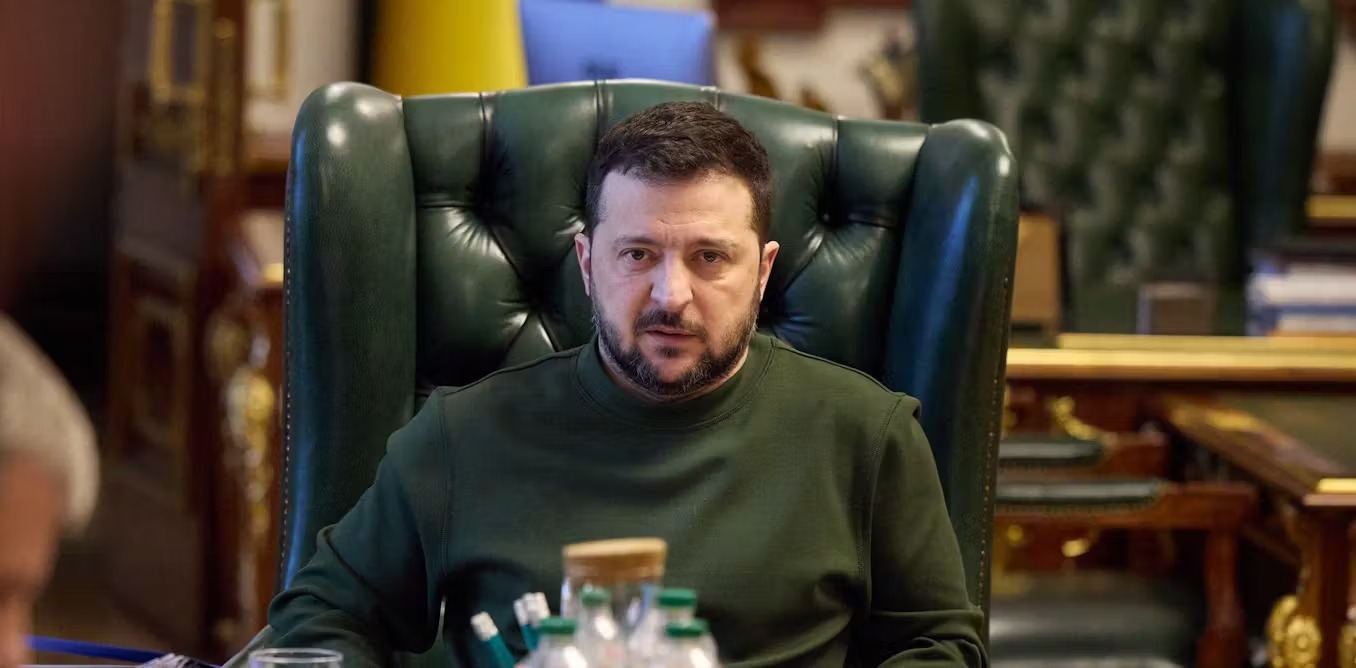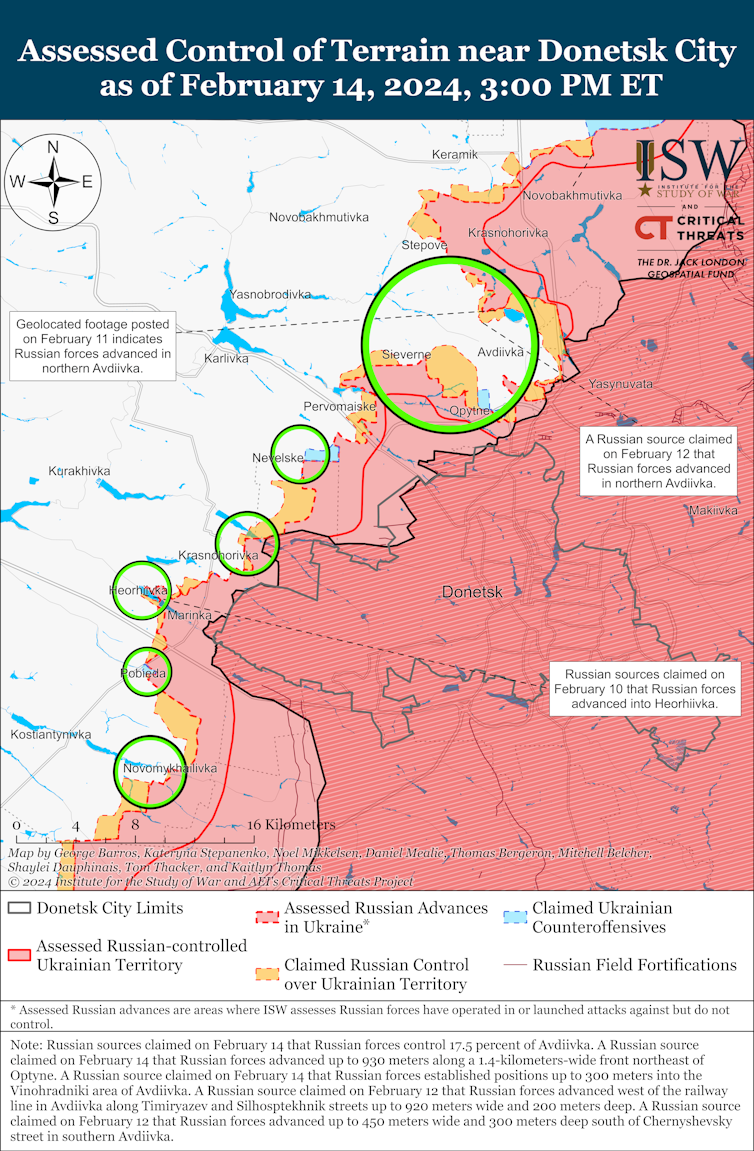It’s appropriate, a fortnight out from the second anniversary of the full-scale Russian invasion, to look back and see what the mood was this time last year as we marked the end of the first year of all-out war in Ukraine. We had just published a piece by two security analysts from the Paris-based research university Sciences Po, who had outlined three possible scenarios for the 12 months ahead.
The first two options were major military setbacks for Russia or Ukraine, with major losses of troops and territory. The third was almost uncannily prescient, envisaging – as it did:
a drawn-out conflict leading to exhaustion and war weariness – not only in Russia and Ukraine, but also among those Kyiv is depending on for the military supplies that are keeping the country afloat.
Which, broadly speaking, fairly neatly sums up the current state of the war in February 2024. Ukraine’s much-anticipated spring 2023 counteroffensive got under way later than had been hoped and when it did, Ukrainian troops found themselves facing extensive and well thought-out Russian defensive lines. Months of bitter, attritional fighting resulted in few Ukrainian gains at a significant cost in terms of both manpower and precious materiel.
Worse, Ukraine’s forces found themselves being pushed back in various areas along the frontline and, in others, caught up in desperate and bloody defensive efforts around towns and cities long since reduced to rubble. The town of Avdiivka, in the eastern Donetsk Oblast with a pre-war population of more than 32,000 people, now looks set to join placenames such as Bakhmut and Soledar as costly and morale-sapping defeats.
In an attempt to change the momentum, which in recent months has been with Russia, Ukraine’s president Volodymyr Zelensky last week replaced his commander-in-chief Valeriy Zaluzhnyi with Gen Oleksandr Syrskyi – who masterminded the defence of Kyiv in May 2022 and the successful counter-offensive in late summer which saw Ukraine recapture significant territory.
The battle for Avdiivka and Donetsk, February 2024. Institute for the Study of War
But, as Stefan Wolff and Tetyana Malyarenko point out, Syrskyi is also associated with the defence of Bakhmut, a battle that consumed so many lives on either side. Wolff, an expert in international security from the University of Birmingham, and Malyarenko of the University of Odesa, are concerned that there are as yet few signs of any fresh strategic thinking from Ukraine’s military planners which might begin to turn things around.
They also point to the fact that Ukraine’s remarkable battlefield successes in 2022 came when western support for Ukraine was in full swing. But fresh supplies of weapons and ammunition from the EU and the US began to dry up in 2023, seriously hamstringing the Ukraine army’s ability to gain the initiative on the battlefield.
In both cases there was an identifiable rogue element: in the case of the EU it was Hungarian president, Viktor Orbán, who vetoed EU military aid to Ukraine for some months, only relenting in Janaury under intense pressure from other EU heads of government. In the US, it was Donald Trump. Trump, who famously said he could bring an end to the war “in a day”, has strongly opposed giving more aid to Ukraine and for months has bullied his wing of the Republican party into obstructing Joe Biden’s US$95 billion (£75 billion) aid package in the US Senate.
After months of bitter debate the bill finally passed the senate this week. But, as Dafydd Townley, an expert in US politics from the University of Portsmouth, writes here, there is no guarantee that the bill will even be brought before the House of Representatives, let alone receive the House’s approval, given the GOP’s majority there.
Incidentally, it’s worth looking at what surveys of the American public say about whether their government should support Ukraine and, if so, in what way. Paul Whiteley, a professor in the department of government at the University of Essex, found that support for Ukraine tended to divide down party lines, with Democrats tending to think the US should continue – or do more – to support Ukraine, while by contrast many Republicans thought the US had already spent too much on aid.
A fair few independent voters felt the same way, which probably helps explain Republican obduracy over supplying more arms and ammunition, despite the fact – as has been regularly pointed out – that much of the $60 billion-plus provided for by Biden’s latest bill will never leave the US and will go straight to buy American arms.
Friends and enemies
You may well remember when Donald Trump and Vladimir Putin met in Helsinki in 2018 in the wake of allegations that Russia had interfered in the 2016 election that had sent Trump to the White House. The then US president raised eyebrows (and a few hackles in the US intelligence community) when he said he believed Putin’s assertion that Russia had done nothing to mess with US democracy, seemingly content to take the Russian leader’s word over his own intelligence agencies.
One of Trump’s greatest allies in the media, former Fox News host Tucker Carlson, sat down with Putin for a two-hour interview last week. Inderjeet Parmar, an expert in US politics at City, University of London, watched the interview and gives us his verdict.
Given Carlson’s core audience, it was a chance for the Russian president to speak directly to the Make America Great Again (Maga) constituency and he took the opportunity – with a fair bit of help from Carlson – to repeat Kremlin talking points (namely: if America stops sending weapons to Ukraine the war will be over in no time), while picking holes in the Biden administration’s performance.
Putin began the interview with a half-hour primer on Russian history designed to back his oft-repeated assertion that Ukraine has always been part of Russia and that the two countries have a shared history going back to the 8th century. He followed this a few days later by placing sanctions on a group of UK historians – “so-called academics” who “make a significant contribution to the subversive work of London against Russia”.
Nick Mayhew, an expert in Russian history and culture, is familiar with the foundational myths that Putin is so fond of and says it’s “so spurious that it requires the silencing of credible historians”. Much of the story comes from a 12th-century chronicle which, among other things, attempts to trace the origins of the Slavic people back to Noah’s Ark. He concludes: “Putin’s early history of Ukraine is part of a Russian imperialist story that has been told for centuries. Only it is exactly that, a story.”
Incidentally, Putin’s origin story includes Belarus as a land that was also part of early Russia. And there’s little doubt that the Kremlin has a large amount of influence over the government there with Belarus president Alexander Lukashenko counted among his closest allies and most faithful supporters.
The same can’t be said for the Belarus people, who are by and large fairly sick of Lukashenko and dead set against joining the war on Moscow’s side. Natasha Lindstaedt, an expert on post-Soviet eastern Europe at the University of Essex, says 97% of Belarusians are opposed to deploying their country’s troops in Ukraine and the vast majority wouldn’t blame a soldier who refused to fight on Russia’s side.
As she notes here, despite Russia’s iron grip on their country’s economy and the Kremlin’s influence over their government, the people of Belarus are not inclined to believe Russian propaganda about the war. In fact, she writes, they tend to disbelieve pretty much everything their own government says.
It’s unavoidable though, in the intense battle for hearts and minds, that some in Ukraine have opted to side with Russia for one reason or another. Ronald Niezen of the University of San Diego says that in areas occupied by Russia and now retaken by Ukraine, the search is on for collaborators. He says more than 7,000 criminal cases have been opened accusing Ukrainians of giving aid to the enemy.
Some, he writes, are fairly clear-cut instances of Ukainians providing the invaders with information about Ukrainian targets or those among their neighbours who might become partisans and fight behind the lines. Others are less so: people who continued to do their jobs after their town was occupied: local government officials, garbage collectors and the like.
Niezen, who writes that his own father died leaving his family with doubts about his conduct in occupied Netherlands during the second world war, cautions against the same outbreaks of vigilante violence that broke out in many countries once the Nazi occupiers were driven out.



 How the U.S. could in fact make Canada an American territory
How the U.S. could in fact make Canada an American territory  Tropical forests can be revived after logging – if they’re not turned into oil palm plantations
Tropical forests can be revived after logging – if they’re not turned into oil palm plantations  Gold Soars Amid Tariff Woes: Market Dynamics and Labor Trends Unfold
Gold Soars Amid Tariff Woes: Market Dynamics and Labor Trends Unfold  Solana's Meteoric Rise: Price Trends, Whale Accumulation, and Future Predictions
Solana's Meteoric Rise: Price Trends, Whale Accumulation, and Future Predictions  Entrepreneurs need to be protected from burnout too
Entrepreneurs need to be protected from burnout too  Gold Prices Steady Amid Geopolitical Tensions and Market Watchfulness
Gold Prices Steady Amid Geopolitical Tensions and Market Watchfulness  MANTRA Blockchain: Pioneering Real-World Asset Integration and Bullish Momentum
MANTRA Blockchain: Pioneering Real-World Asset Integration and Bullish Momentum  Gold Shines Bright as China's Buying Spree Bolsters Prices
Gold Shines Bright as China's Buying Spree Bolsters Prices  Ethereum Faces Stormy Waters: LTH Selling, Major ETF Outflows, and Critical Support Levels Ahead
Ethereum Faces Stormy Waters: LTH Selling, Major ETF Outflows, and Critical Support Levels Ahead  The upcoming election is a critical juncture for Canada’s climate policies and the carbon tax
The upcoming election is a critical juncture for Canada’s climate policies and the carbon tax  Gold Soars as Safe-Haven Demand Surges Amid Rising U.S. Treasury Yields and Strong Jobs Data
Gold Soars as Safe-Haven Demand Surges Amid Rising U.S. Treasury Yields and Strong Jobs Data  Gold's Fortitude Tested: Economic Signals and USD Strength Shape Market Outlook
Gold's Fortitude Tested: Economic Signals and USD Strength Shape Market Outlook 


































